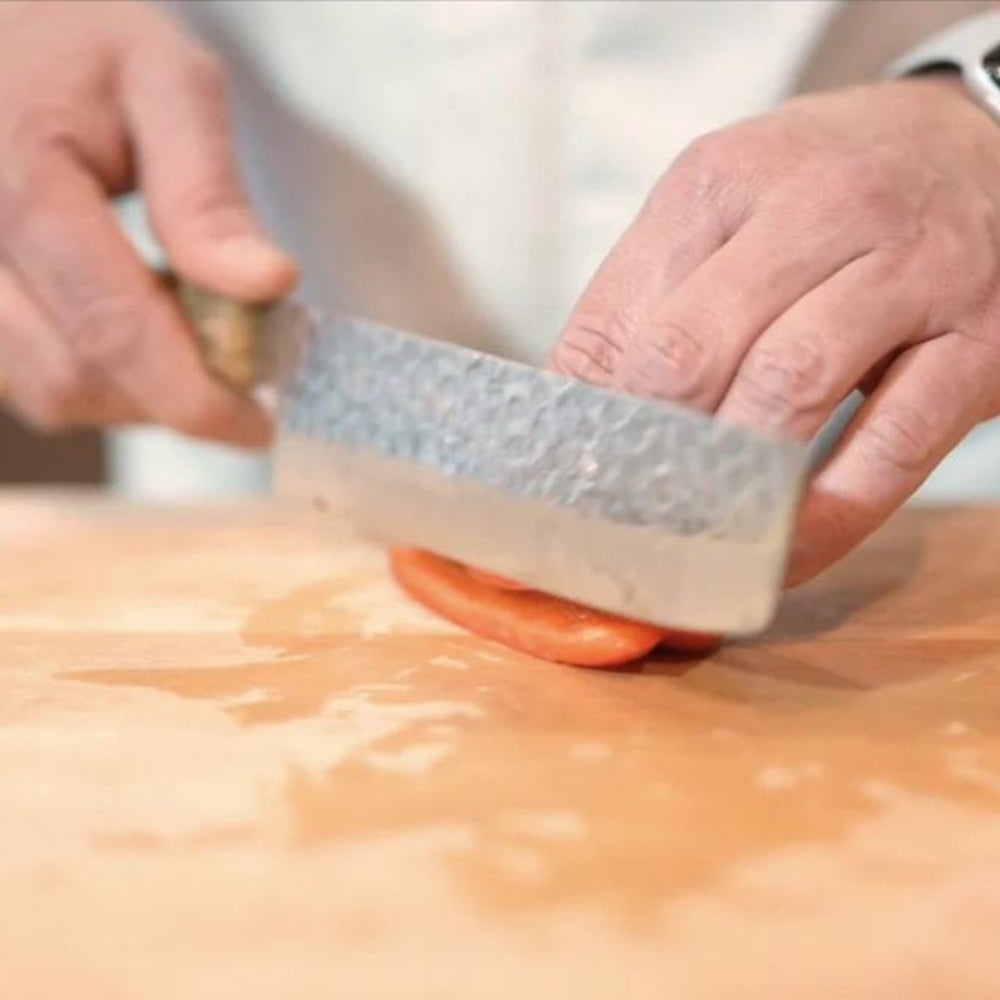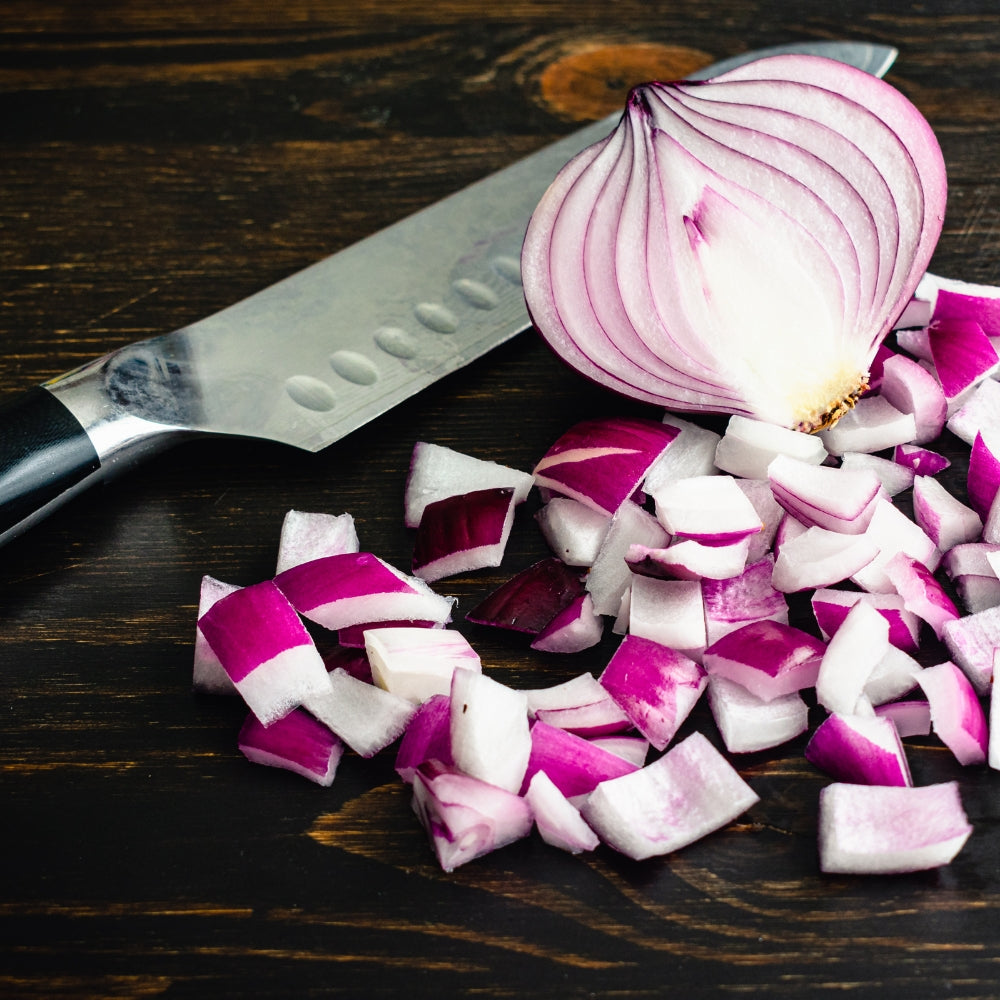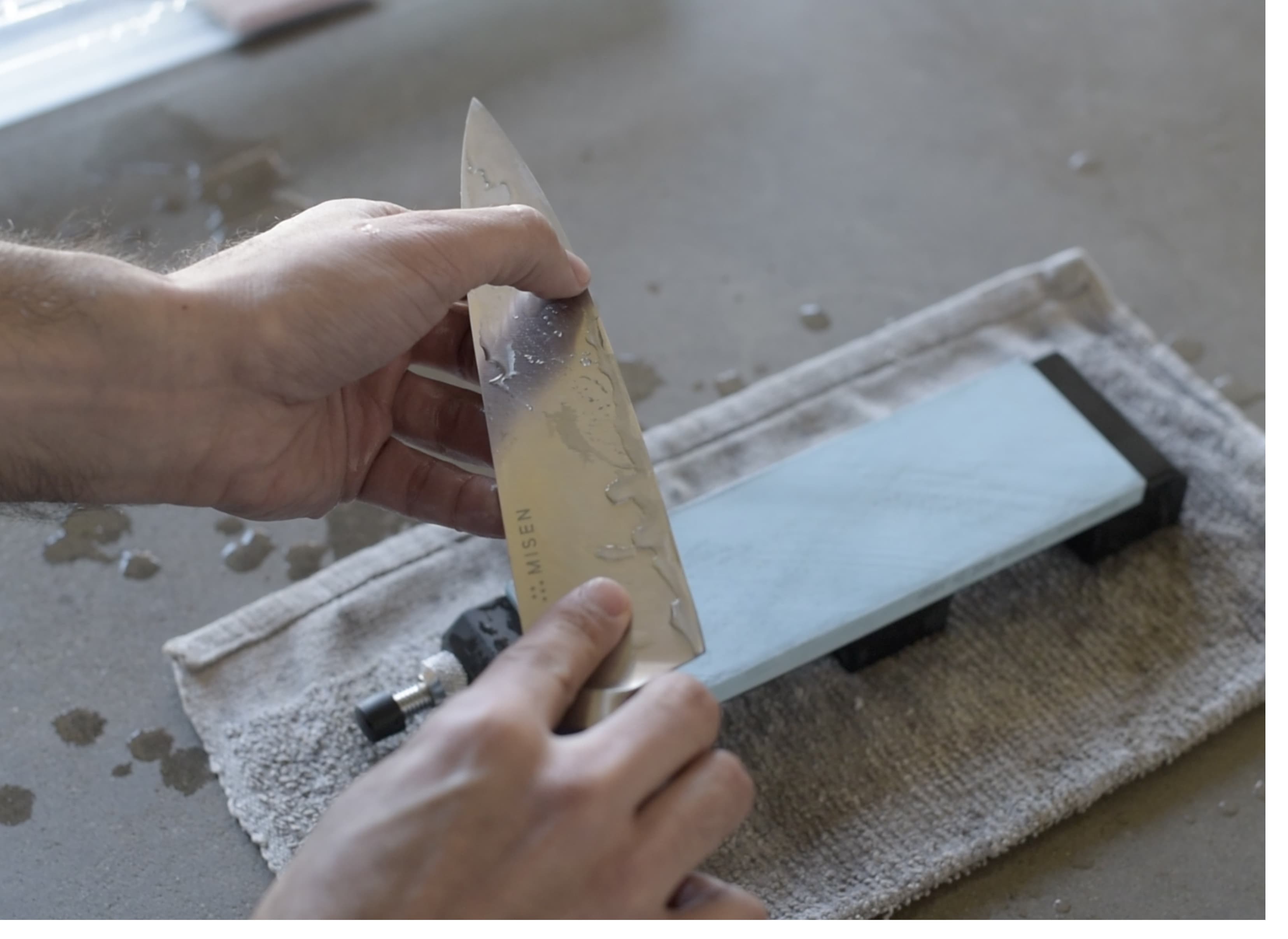
Nakiri Knife vs Santoku: The Ultimate Kitchen Showdown
By Kenny Trusnik
Senior Food Writer at Pro Home Cooks
When it comes to the culinary world, a great debate often arises around nakiri knife vs santoku. These two Japanese kitchen knives each have their unique strengths and applications, making them both favorites among professional chefs and home cooks alike.
The nakiri knife, with its straight-edge blade, is hailed as the ultimate vegetable specialist. Its design allows for precise cuts that preserve the integrity of your fresh produce.
On the other hand, the versatile santoku knife is an all-purpose ally in any kitchen setting. From slicing meat to mincing herbs, this tool can handle a wide range of food items with ease and precision.
In our exploration of nakiri knife vs santoku today, we'll delve into their history, key features and why you might choose one over another depending on your cooking style. Let's dive right in!
Ready to elevate your culinary game? Dive deeper into our top Japanese knives. Explore now!
Table of Contents:
- The Art of Japanese Knives: Nakiri vs Santoku
- Unveiling the Nakiri Knife - The Vegetable Specialist
- Exploring Key Features of a Nakiri Knife
- Why Choose Nakiri?
- The Santoku Knife - A Versatile Kitchen Essential
- The Versatile Santoku Knife - An All-Purpose Ally
- Highlighting Key Features of a Santoku Knife
- Why Choose Santoku?
- Comparing Blade Lengths & Weights - How These Knives Measure Up
- Blade Lengths & Weights - Nakiri vs Santoku
- Understanding Edge Grind & Cutting Techniques
- Cutting Techniques Suited For Each Type
- Nakiri: Mastering The Straight-Edge Technique
- Santoku: Harnessing Double-Bevel Precision
- FAQs in Relation to Nakiri Knife vs Santoku
- Conclusion
The Art of Japanese Knives: Nakiri vs Santoku
Japanese knives, specifically the nakiri knife and santoku knife, are not just tools but a testament to Japan's rich history. They represent years of tradition blended with cutting-edge culinary craftsmanship.
The Edo Era Influence on Knife Design
Inspired by the elegance and simplicity characteristic of Japan's Edo era, these Japanese kitchen knives embody historical significance alongside practicality. The blade design is reflective of this period; it has been thoughtfully crafted for both functionality and aesthetic appeal.
Nakiri knives often come adorned with traditional Japanese imagery etched onto their blades - an ode to its cultural heritage. This rectangular-shaped vegetable cleaver stands out due to its straight edge blade designed for precise chopping without any push or pull motion required by other western style blades.
Santokus offer a polished finish that accentuates their sleek form factor while providing versatility in use - from slicing meat to mincing herbs effortlessly owing largely in part to the curved spine which allows rocking cuts, making them an ideal all-purpose chef's tool in kitchens around the world. Blade design, therefore, plays an essential role when choosing between different styles based on cooking needs and preferences.
These variations highlight how specific designs cater better towards certain food preparation techniques over others, making each type uniquely beneficial depending upon individual requirements.
Now we've established some background knowledge about these iconic Japanese tools, let's delve deeper into specifics starting off by exploring more about our first contender - The Nakiri Knife.
Unveiling the Nakiri Knife - The Vegetable Specialist
The Nakiri knife, a product of Japanese culinary tradition, is often overlooked in home kitchens. However, this unique tool brings together everything you love about your favorite knives into one specialized utensil for chopping vegetables.

Exploring Key Features of a Nakiri Knife
Nakiris are not designed with innovation but rather purpose - their straight edge and squared edges give them an unmatched ability to chop through any vegetable. While most Western-style knives have pointed tips, the nakiri's flat tip aligns perfectly with its blade making it ideal for clean cuts on your cutting board.
This lightweight knife offers similar benefits as stainless steel counterparts; easy maneuverability while prepping delicate ingredients like bell peppers or tomatoes without causing unnecessary damage due to weight pressure.
Why Choose Nakiri?
If you're frequently preparing salads or stir-fry dishes at home, investing in a nakiri knife would be beneficial because they make quick work out of large quantities by delivering uniform cuts every time, regardless if you're working with firm root veggies such as carrots or softer ones like zucchinis. These thin slices ensure even cooking whether sautéing or roasting them, which makes all the difference when aiming for perfect results each time.
The Versatile Santoku Knife - An All-Purpose Ally
Santoku knives, the unsung heroes of many kitchens, are as efficient and practical as they come. They're not just another type of chef's knife; these Japanese-style tools bring together everything you love about kitchen cutlery into one multi-purpose tool.

Highlighting Key Features of a Santoku Knife
Just like your favorite all-purpose kitchen utensils, santokus offer an array of features that make them stand out from other types. Their shorter blade length is easier to manage than longer western-style blades, yet it doesn't compromise on performance.
The design includes a curved spine for easy rocking motion during chopping tasks - similar to how carbon steel pans distribute heat evenly across their surface. Furthermore, hollow edges along the sides create small air pockets between food and blade, which prevent sticking after each slice, much in the same way non-stick coatings work on modern cookware.
Why Choose Santoku?
If there's one thing we know at Pro Home Cooks, it's this: if you enjoy cooking, then choose santoku. This general-purpose knife handles everything from finely chopping vegetables to cleanly slicing through meat with ease and precision, thanks largely to its balanced weight distribution across the blade and handle alike, making life simpler overall. This is especially beneficial for busy parents who enjoy cooking but don't always have extra time to spare throughout the day managing household chores alongside preparing meals.
In fact, using these versatile tools requires less maintenance than some others, such as those made from reactive materials needing regular seasoning sessions. Instead, simply cleaning after usage will suffice, keeping them sharp enough long-term without much effort required at the user's end. This enhances durability while also improving cutting capabilities over time, akin to a seasoned cast iron pan becoming more effective with every use, whether in a high-heat oven or scrubbing hard under the tap before storage. Stacked up against other pots and dishes inside a cupboard where space is often a premium commodity in most households today, this proves once again why owning a good quality, reliable set is an essential part of any well-equipped home kitchen setup, regardless of size, layout, personal culinary preferences,
Think of the Santoku knife as your culinary Swiss Army Knife. Its shorter, manageable blade and curved spine make for easy chopping while its hollow edges prevent food from sticking to it. Ideal for busy home cooks, this versatile tool requires minimal maintenance yet delivers maximum performance in slicing and dicing tasks - a true all-rounder in any kitchen arsenal.
Comparing Blade Lengths & Weights - How These Knives Measure Up
In the world of cooking, a knife's blade length and weight are pivotal elements that can greatly shape your culinary journey. Whether you're tasked with chopping hard root vegetables or mincing soft herbs, achieving precision and comfort in every cut hinges on finding the right balance between these two factors.
Blade Lengths & Weights - Nakiri vs Santoku
The Nakiri and Santoku knives both originate from Japan but have distinctive features when it comes to their dimensions and heftiness. Typically, a standard Nakiri knife boasts a blade length within the 12-18cm range, which is similar to an average-sized Santoku.
But there's more than just long blade lengths at play here. The real difference surfaces when we delve into their weights. On one side of this comparison stands the lightweight champion - the Nakiri; while on its opposite end lies its heavier contender - the Santoku Knife.
A typical Nakiri weighs only about 4 to 6 ounces per handle length, making it an ideal choice for those who favor lighter tools in their kitchen arsenal. Its feather-light nature allows swift movements during vegetable chopping tasks without causing fatigue even after extended use.
In stark contrast, a conventional Santoku tips the scales around 155-227 grams depending upon its make-up details. This added mass lends stability during forceful cutting chores such as slicing through meat or tough-skinned fruits like melons.
To sum up: While both types share comparable lengths, they diverge considerably concerning weight distribution across handles, thus rendering them suitable for different kinds of food prep based on individual preferences regarding handling ease versus control over cuts.
Now let us move forward by examining how each type's edge grind influences cutting techniques used by professional chefs as well as home cooks, thereby making each type perfect for certain tasks.
When it comes to Nakiri vs Santoku knives, the blade length is similar but their weights differ significantly. The lightweight Nakiri knife enables swift vegetable chopping without fatigue, while the heavier Santoku offers stability for forceful cuts through meat or tough fruits. Your choice depends on your preference between handling ease and control over cuts.
Understanding Edge Grind & Cutting Techniques
The grind of a knife's edge can be the determining factor in its cutting technique. Each type has unique advantages, and understanding them is key to maximizing your kitchen tools.
Cutting Techniques Suited For Each Type
A Nakiri knife boasts a flat-edge grind that excels at up-and-down chopping motions. This blade design allows for thin, precise cuts - perfect for slicing through vegetables without compromising their structure or texture.
In contrast, Santoku knives employ a double-bevel edge grind. The beveled edges form two sloping sides that meet at the cutting point. This facilitates push-cutting techniques where the entire length of the blade makes contact with food in one smooth motion.
While these are typical uses based on each type's design characteristics, skilled chefs often adapt their techniques depending on what works best for them personally or suits specific tasks better; it ultimately comes down to personal preference and comfort level when handling these tools.
Nakiri: Mastering The Straight-Edge Technique
- Safely position your fingers away from the path of action.
- Lay out your vegetable against your board.
- Gently press down, applying even pressure along the full span until passing cleanly through whatever ingredient is being chopped. This approach ensures clean slices every time.
Santoku: Harnessing Double-Bevel Precision
- Place the item under the front part (tip) where the curve begins.
- Pull back towards the heel end while applying downward force simultaneously.
- Then only the tip lifts, leaving the heel grounded before repeating the process again. Remember, practice always improves skill. A sharp Chef's Knife helps too.
FAQs in Relation to Nakiri Knife vs Santoku
Which is better santoku or nakiri?
The choice between a Santoku and Nakiri depends on your cooking needs. For versatile cutting tasks, the Santoku shines. If you frequently chop vegetables, the Nakiri might be your best bet.
What's the difference between santoku and nakiri knife?
Santokus are all-purpose knives with a curved spine for rocking cuts, while Nakiris have straight edges ideal for chopping vegetables using an up-and-down motion.
What is a nakiri knife good for?
A Nakiri knife excels at slicing through delicate ingredients like bell peppers without crushing them thanks to its straight edge and squared ends.
What is a Santoku Knife best used for?
The Santoku Knife is great for handling various food items, from slicing meat to mincing herbs, due to its general-purpose design and hollow edges that prevent sticking.
Conclusion
The world of Japanese knives is fascinating, with the nakiri knife and santoku offering unique features for different kitchen tasks.
From their historical Edo era influence to modern-day use, these knives have proven their worth in both professional kitchens and homes around the globe.
Nakiri, with its straight-edge blade and lightweight design, shines as a vegetable specialist. It delivers clean cuts that make your food prep more efficient.
Santoku's versatility is unmatched. Its shorter length but wide range of uses makes it an all-purpose ally in any kitchen setting - from slicing meat to mincing herbs.
Despite similar lengths, differences in weight between these two types can significantly affect handling and comfort during long cooking sessions. Nakiris are typically lighter than Santokus which may be preferred by some chefs or home cooks depending on personal preference or task at hand.
The edge grind influences cutting techniques suited for each type; whether you prefer up-and-down motion using a flat edge like Nakiris or push cuts using a double-bevel edge as seen with Santokus will ultimately determine which one ends up being your go-to knife in the kitchen!
Transform your kitchen experience with the best tools handpicked by Mike. Don't miss out on these essentials. Check out our top selections now!
TOP ARTICLES

Sourdough Baking School
Master the art of sourdough bread baking in the most comprehensive baking class on the internet. This class features over three hours of baking content to help you start your sourdough journey.
See More




